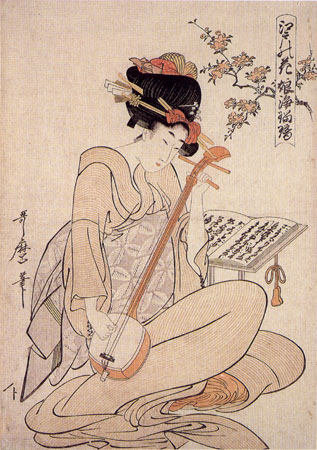Kitagawa Utamaro
Kitagawa Utamaro was an ukiyo-e artist, known especially for his bijinga (images of beautiful women).
He studied under, among others, Toriyama Sekien.
Utamaro's bijinga marked a notable shift in that sub-genre, setting a new standard for the form. Though his works show the influence of Torii Kiyonaga, he departed from the slender, willowy figures of Kiyonaga and Suzuki Harunobu before him, often depicting women who appear more mature, full-figured, and sensual, and less delicate or graceful. Several of his most famous series of bijinga showed events and activities of the pleasure districts throughout the day, or across the year, providing a glimpse into the lives of courtesans, and the secret world they inhabited, beyond only what they showed to clients.
Utamaro, along with Kiyonaga, was also a pioneer in making greater use of the polyptych, publishing a number of series of images which stretch across more than one single-sheet print. While previous artists occasionally produced works in pairs or groups of three, a number of Utamaro's works span six or eight sheets, arranged in two rows. These were sold separately as collectors' items at the time and remain so today.
He published prints with a number of publishers, including Moriya Jihei,[1] but is likely most known for his business relationship with Tsutaya Jûzaburô, who published many of Utamaro's most famous prints, beginning in 1782. Tsutaya even allowed Utamaro space to live in his house for a time.[2]
In 1804, Utamaro fell afoul of official shogunate censors. Though enforcement of shogunate restrictions on publishing was quite lax throughout much of the Edo period, at that time, around 1804, enforcement was suddenly stepped up. A triptych by Utamaro depicting Toyotomi Hideyoshi cavorting with courtesans (and therefore terribly disrespectful to the samurai class), and/or perhaps other of Utamaro's works, caught the eyes of the censors, and the artist was sentenced to house arrest. He was placed in manacles, and though later released, he never recovered. He produced very little work over the next two years, and died in 1806.
Utamaro's students included artists who took on the names of Kitagawa Utamaro II, and Kitagawa Utamaro III (also known as Koikawa Harumachi II).
